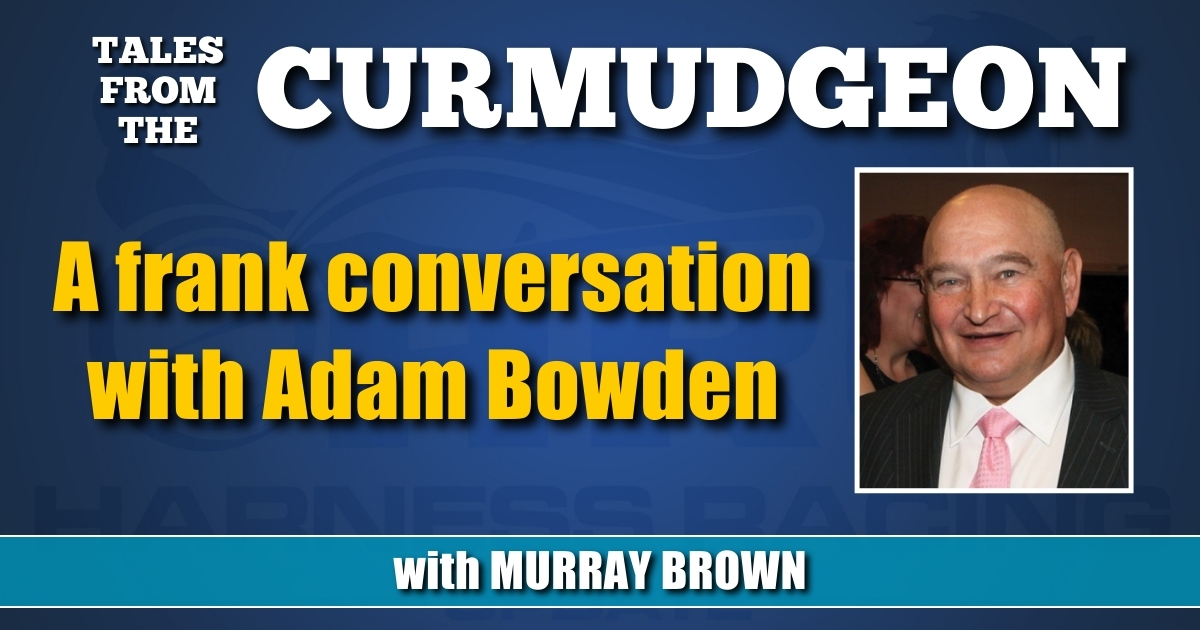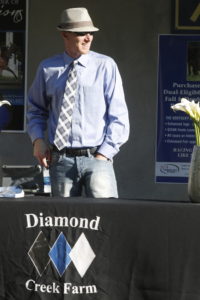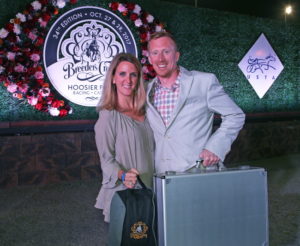A frank conversation with Adam Bowden
The owner of Diamond Creek Farm burst on the scene in 2005 by spending a million dollars on horses and vowing to play at the top of the game. Adam Bowden has been a fixture among the sport’s elites ever since.
by Murray Brown
It was in November 2005 when an unfamiliar name began appearing on the sales results sheets at the annual Harrisburg sale. The name was Adam Bowden and the horses purchased were not of the cheap variety. For the most part, they were top of the line horses with quality pedigrees.
The total spent was well over a million dollars. It is on occasions such as this that sales managers start to shiver. I know. I’ve been there. I’ve also been stung.
It was time to introduce myself to this new buyer.
The name Adam Bowden seemed vaguely familiar. I paged him and congratulated him on his purchases and wished him the best of luck with them. Then the touchy question: “How and when are you going to pay for them Adam?” I was told that the money would be wired within a few days. True to his word, that’s exactly what transpired. I then remembered who Adam Bowden was. He was a young man who had spent two summers apprenticing at Hanover Shoe Farms attempting to soak up some of what it takes to run a successful horse farm.
Initially, most people, perhaps myself included, thought that he was another newbie who was ready to be taken to the cleaners by the vultures, also known as horse agents. The majority of horse agents are not dishonest or dishonorable. However, the ones who are, are generally the first to try to take advantage of “fresh meat” entering the marketplace.
But contrary to the general assumption, Bowden had done his homework. His ambition was to establish a high quality standardbred breeding farm.
Most people entering our business get the horses first and then expand to the point where the need or desire for a place to house them occurs through the progression of time. Adam did it in reverse. He, together with his dad, Chris, had purchased 180 acres of prime real estate in Paris, KY from the late John Magnuson. This was to be the site of Diamond Creek Farm.
Adam came to the breeding game well prepared.
He is from the small town of Cumberland, ME where his parents and grandparents had some cheap horses.
He quickly became smitten with the horse bug. But he didn’t want cheap horses. He wanted to play with the big boys at the top of the game.
After graduation from college with a degree in biology and chemistry, he began following the sport with great intensity. He started keeping records and developing theories and a game plan.
First, he felt he had to learn about the physiology of the horse, especially its feet. Growing up, he had often heard the expression “no foot no horse.” He spent two years in farrier school working mostly with show horses, but with the occasional standardbred.
After purchasing the land that was to become Diamond Creek Farm, he needed to stock it with mares. Thus, his trip to the Harrisburg Sale in November 2005. The plan was to buy five mares, concentrating on quality. With only five horses, he wouldn’t need help. He could do it all himself.
However at Harrisburg, things got away from him. He left the sale with 20 broodmares, five yearlings and five weanlings.
There was still only Adam to take care of these 30 horses. The yearlings were not an immediate problem as he apportioned them off to trainers who would prepare them to race.
The mares and weanlings were his to take care of. He managed to foal all the mares and raise the then yearlings all by himself.
“It wasn’t easy” he said. “But I managed to get through it with a little heartache thrown in, something that affects anybody in the breeding business.”
The number of mares that Diamond Creek owns now numbers in the 60 range, although it has been as high as 82. This, together with a group of about 20 retirees and a commensurate number of yearlings and foals, and 32 horses in training, adds up to a very significant equine population.
Adam and I recently had several conversations while he, his wife Lindsay and daughters Finley and Grace were on a skiing expedition in Montana. Their one-year-old son Roman is a little young to be included this time, but I was assured that he will be with them on future trips.
Adam, let’s begin with your training stable. You’ve got 32 horses in training, That’s a pretty big investment and speaks well for your confidence in the sport.
“Like most people in this business we’re always looking for the home run horse. We own most of them entirely, but we do have partners on some. I’m pretty much of a lone wolf type of personality. I prefer to captain my own ship whether it be for good or bad. It’s not that I don’t like partners. Everybody that I’ve partnered with in the business has been “good people.” I don’t recall ever having a dispute with any of my partners. It’s just the I prefer to make all my decisions and not to be beholden to anybody else or have them beholden to me.
“We’ve taken our racing stable to another dimension in that, like with some thoroughbred outfits, we have our own stable racing manager, Marcus Johansson, who is an outstanding horseman and oversees all of our horses in training. He went to arguably the best school that our sport has, that of Jimmy Takter.
“I’ve learned that, generally speaking, horse trainers are among the most optimistic of beasts to be found on this planet. Marcus is able to give us an unbiased opinion of what we have being trained. In addition to having been an accomplished horse trainer, he was also a more than adequate driver. He is able to sit behind our trainees and tell us what he thinks without any bias.”
How do you pick your trainers?
“As you know, we have them with several trainers, most of them headquartered in New Jersey. I’ve tried many trainers and probably as many venues. Most recently I’ve had a great trainer such as a Jimmy Takter type come to the farms and have him pick the ones he would like to see trained. I don’t think there is any perfect way of doing it. However, we’ve had some recent success doing it this way.”
Do you think that having that many horses in training, most of them homebreds hurts you as a market breeder?
“It probably does. But we try to apportion our yearlings into two groups. One of those groups consists of the ones we consider the most commercially attractive. That group goes to the sale. The other group is made up of those from whose dams we have generally put into training. A good many of those in the latter group consists of fillies who’s blood we want to retain and build on and keep as future broodmares.”
You also dabble in thoroughbreds. How did that come about and how has it worked for you?
“Lindsay and I were in Ireland a few years ago for the Vincent Delaney Memorial. While we were there, we took a trip to Coolmore Stud, arguably the top thoroughbred breeding farm in the world. While we were there, they showed us a list of some mares they might have for sale. We bought two of them. We now own 10 thoroughbred mares. We keep and foal them at Ashford Stud in Lexington, which is Coolmore’s farm in the States. We do raise their foals at our farm in Kentucky with our standardbreds. We utilize agents to sell our yearlings at the select sales. I would say we’ve been fairly successful.”
You mentioned your retirees. Good for you.
“I suppose that I picked that up at Hanover. They have a group that numbers well over a hundred. I remember thinking that’s only right. We benefit from them. It’s only right that when their production years are over that we provide a good home for them. The Crawfords, and I believe Winbak, do much the same.”
You started off with a farm in Kentucky. You’ve now expanded to Pennsylvania and also have had aborted deals in New York and New Jersey.
“An ideal horse farm became available in Pennsylvania. That’s where the best sires stakes and breeders rewards programs were situated so we bought it. It’s where we stand most of the stallions with which we are affiliated. When asked why we moved there, it’s like the celebrated bank robber Willie Sutton said when he was asked why he robbed banks, ‘Because that’s where the money was.’”
In the past years you’ve had plans to establish farms in New York and New Jersey. Neither one came to fruition. What happened?
“In the case of the New York farm, I bear full responsibility. I acted before I polled our customers and assessed the marketplace. We had plans to stand world champion Lather Up there. The feedback I received from our customer base and the industry was that most people were not willing to send their mares, especially mares with foals at their side, to New York because of their stringent residency rules. Rather than risk the chance of the horse not getting the support that one of his ability deserves, we made the decision to stand him at Sugar Valley Farms in Ohio where he serves a full book of mares. In retrospect, I believe Ohio was a better place for him anyway.
“As far as New Jersey is concerned, I’m still not quite sure of what happened. I thought we had reached a deal to stand Tall Dark Stranger there. We had a farm. We had already purchased equipment for the breeding shed. Thankfully, we never made a public announcement before the paperwork was completed. But the word was out through the industry. For reasons I’m still not sure of, I found that the horse was going to Hanover. But that’s business. They got him, we didn’t. That didn’t prevent us from buying a share and booking several mares to him.”
To a great extent, when it comes to going after a top horse to become a stallion there’s you and there is Hanover. Most of the others are bit players.
“I think we both have a lot to offer. It depends on the needs of the sellers. If they are looking to realize the most money, especially short term, I believe that we have the most to offer. We have done very well for our shareholders, especially when one considers the money to be made by shipping horses to the Southern Hemisphere.
“Although Hanover has done so on occasion, it’s pretty well known that they are reluctant to do it. However in terms of commitment, insofar as the number of mares that they are willing to commit to a horse in its formative years, they have everybody else beat by a country mile.”
Considering the risk factor, you guys are willing to invest significant dollars in a young horse that shows promise early in the game much more than just about anyone.
“That is part of our overall game plan. Sometime it works, other times not as well. I believe it’s worth the risk in order to be able to stand the horse if he becomes as good as we hope that he will.”
How active are you in the running of your two farms?
“I would say pretty active. I spend most of my time in Kentucky at the farm there, but I go to the Pennsylvania farm about one week every month. There is nothing of consequence that takes place without my knowing about it. If that makes me a control freak, then I suppose that is what I am.”
You presently own 60 broodmares. Do you anticipate growing much more?
“Not very much. For us, the ideal size is between 60-80 mares. Like everything else in this world, its subject to change. Remember you are speaking with the guy who first went to Harrisburg to buy five mares and left the sale with 30 horses.”
Of all the horses you’ve owned or been associated with, do you have a favorite?
“Creatine for sure. He overcame all obstacles. He was supposed to be sold as a yearling, but he injured a hock before the sale and had to be withdrawn. From that point forward, he became a physical mess. He lost weight and lacked energy. I remember calling my dad and telling him that it appeared that we might have to put him down. My dad suggested we just kick him out and let nature take its course. ‘Just let him be a horse.’ We brought him in as a 2-year-old and dad suggested that we give him to 80 year old Donnie Richards in Maine to fool with. After awhile, Mr. Richards offered $10,000 for him. We turned it down. A month later, the offer was $50,000. Our answer was the same. ‘This might just be the best horse I’ve ever trained,’ said Richards. We sent him to Bobby Stewart in Kentucky and he won the Kentucky Futurity. We raced him in Europe. He ended up earning over $2 million dollars. He’s now standing at Sugar Valley Farm in Ohio.”
Diamond Creek entered the horse agency business last year. It appears that you have plans to expand it.
“It was somewhat happenstance that we first became involved. We have been friends and partners with Shmuel Farhi who owns Farhi Standardbreds in Canada. It appeared to me as though he and I had similar goals, to play the game at the top and concentrate on quality. Because of COVID-19, they were in a bit of a pickle insofar as sending their help with their consignment to Timonium. We offered to help in acting as their agent. Considering Covid and the circumstances I thought we did really well. I think our crew can represent a horse as well as anyone. We plan to play the agency game the same way we do with our yearlings. We want and will only accept what we consider to be quality horses. We believe we have a top brand and that anybody that’s looking for a good yearling would be remiss in not visiting our consignment.”
Besides horses, what pleases Adam Bowden most?
“Of course, my family is first. Both Lindsay and I love to travel and we do a lot of it. I’m very much into exercise of all sorts. I’m an avid runner. I do the triathlon. I love skiing and biking — just about everything that stretches the body to accomplish a little more.”
Have a question or comment for The Curmudgeon?
Reach him by email at: hofmurray@aol.com.






















